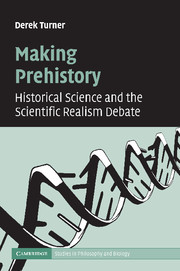Book contents
- Frontmatter
- Contents
- List of figures
- Acknowledgments
- Introduction
- 1 Asymmetries
- 2 The colors of the dinosaurs
- 3 Manipulation matters
- 4 Paleontology's chimeras
- 5 Novel predictions in historical science
- 6 Making prehistory: could the past be socially constructed?
- 7 The natural historical attitude
- 8 Snowball Earth in the balance
- Conclusion
- References
- Index
6 - Making prehistory: could the past be socially constructed?
Published online by Cambridge University Press: 22 September 2009
- Frontmatter
- Contents
- List of figures
- Acknowledgments
- Introduction
- 1 Asymmetries
- 2 The colors of the dinosaurs
- 3 Manipulation matters
- 4 Paleontology's chimeras
- 5 Novel predictions in historical science
- 6 Making prehistory: could the past be socially constructed?
- 7 The natural historical attitude
- 8 Snowball Earth in the balance
- Conclusion
- References
- Index
Summary
The dinosaur is the totem animal of modernity. By this I mean, first, that it is a symbolic animal that comes into existence for the first time in the modern era …
W. J. T. Mitchell, The Last Dinosaur Book (1998, p. 77).Conceptual idealism is a ludicrous and anti-scientific view of the world. Science teaches that the moon existed long before we or any other concept-mongers did and is not the sort of thing that can be created by thought or talk.
Alan Musgrave (1999, p. 351).Two positions: realism and nonrealism. And essentially we seem to be no further ahead than when we started!
Michael Ruse (1999, p. 253).Did paleontologists discover dinosaurs or did they make them? Is it even conceivable that the past could depend on the present? I will argue, contra scientific realists, that for all we know the distant past could be socially constructed, but that there is also no good reason for thinking that it is socially constructed. Like the religious skeptic who admits that the stories of the Christian tradition might be true, but sees no good reason for thinking that they are true, I counsel agnosticism on the whole question of metaphysical realism vs. social constructivism. Someone who follows this policy will endorse neither the radical constructivist view of W. J. T. Mitchell, nor the realist metaphysics of Alan Musgrave.
- Type
- Chapter
- Information
- Making PrehistoryHistorical Science and the Scientific Realism Debate, pp. 130 - 162Publisher: Cambridge University PressPrint publication year: 2007



